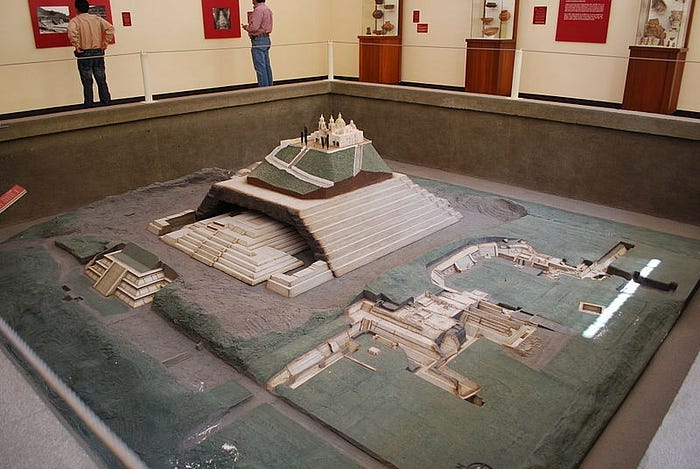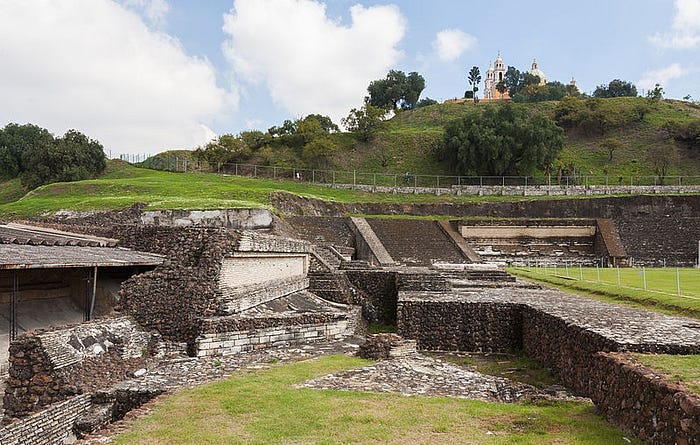The Largest Pyramid In The World Isn’t In Egypt, And It’s Hidden Under A Church
It also grew to its size in stages, over time

“…Hiding under tufts of grass, trees, and soil, is an ancient pyramid of truly gigantic proportions. Standing 450 metres wide and 66 metres tall, from end to end the Great Pyramid of Cholula is equivalent to nine Olympic sized swimming pools.”
— Zaria Gorvett, BBC
The building my company uses as a warehouse has an interesting history. It was originally a hayloft. Imagine that. Dead in the middle of the hood in Philadelphia sat a barn-like structure, complete with a beam on the top of the building used to lift hay bales via a rope.
After that, it was a boxing gym. An old neighbor would tell me about walking upstairs through the narrow hallway to watch neighborhood athletes spar in a ring as a kid. Now, it’s a storage place for cleaning equipment.
What does this have to do with a pyramid? More than you’d think.
Cultures build on top of the past; many times modifying it to fit their purposes. Israel takes this to extremes. Construction in this land regularly involves finding something ancient.
Josie Glausiusz in the Journal Nature, explains a road construction project in 2019 found a five-thousand-year old mega village in En Esur. This sprawling development was built on a previous smaller one. To complete the circle, it was recovered again after excavation to complete the road.
Likewise, the Greek city of Corinth is home to a canal, which crosses the Peloponnese peninsula. However, it also nearly sits atop the Diolkos of Corinth. This ancient causeway transported twenty-ton ships across dry land and was eventually buried.
Keep all this in mind as I introduce you to the largest pyramid in the world: The Great Pyramid of Cholula in Mexico.
It came to its size by stages. Also, like my warehouse, the causeway in Corinth, and the mega village in Israel, it was covered up. Only to be built on later.
The Sacred Mountain
Zaria Gorvett’s article in the BBC mentions the Pyramid of Cholula is the largest pyramid on Earth, with a volume twice that of the Great Pyramid of Giza. Its base itself is four times larger. Yet, the Spanish invaders missed it during their invasion of Mexico.
In fact, they put a church on top of it. At the time of the invasion, it was covered by dirt, and took the form of a large hill or mountain. Talk about cultures building on top of each other.
But this is only one iteration of a holy shrine. Gorvett says the pyramid is a series of pyramids built on top of each other. The natives call it Tlachihualtepetl, or “man-made mountain”. So this demonstrates the local population understood something was hidden under the dirt — something holy.
Rachel Funnel at IFL Science says the pyramid’s placement was purposeful, situated over a natural spring. This was accessible by an internal chamber. Some believe it may have been used as a cave-like portal to the underworld.
Funnel also references archeologist and author Geoffrey McCafferty, who believes the pyramid’s Western side was placed to capture the final rays of sun during the summer solstice.
Although these are only two aspects. There’s really too many to list because this temple wasn’t created by one people and likely represented many beliefs as it passed between cultures. You can see this in its architecture.
A Nested Doll Of The Ancient Mesoamerican World

Funnel continually likens The Great Pyramid of Cholula to a series of traditional Russian Matryoshka Dolls. These series of ever smaller dolls hide within each other. It creates a layered effect, eventually hiding all the smaller iterations within a larger doll.
However the pyramid is a bit different. It’s designed to show most of the consecutive layers, instead of burying them over.
Its core is a square pyramid, which reached nearly sixty feet tall. It was decorated with paintings of images appearing to depict an insect transforming. McCafferty believes it’s a butterfly.
A second pyramid surrounds this, reaching to over two hundred feet high, and adorned with steps on each side. Another wider pyramid was built over this, creating a castle-like structure with a series of platforms around “a central peak”. This temple complex now stretched out to nearly twelve-hundred feet on each side.
McCafferty says tunnels stretching five miles long allow entry to the interior of the pyramid. Also, the construction material changes, with a mix of mud bricks, plaster, and mortar.
It’s thought construction of The Great Pyramid of Cholula began near 300 BC, although the builders remain a mystery. At some point, the structure was covered up by earth, taking the form of the hill we know today. Whether by purpose or weathering, again, that’s a mystery.
However, by the 1500s, the city of Cholula was in the hands of the Aztecs. Well, until Hernan Cortez arrived and slaughtered the inhabitants so he could claim the city for Spain and the Aztec’s gold. A nondescript hill came with it.
It would take four to five hundred years before archeologists discovered the true treasure buried within the dirt.
While this is an interesting story, and an incredible landmark, it gives us something to consider.
Civilization Is A Series Of Nested Dolls

While the Greek general Xenophon marched with his mercenaries through Persia, he came upon a magnificent abandoned city. The locals called it Larisa. They told him it was “inhabited in ancient times by the Medes.”
But the city was actually Calah. It was the military capitol of the Assyrian empire, the superpower of the ancient world. It only took a few hundred years before the locals forgot who they were, once they collapsed. Eventually that city was buried too.
If you want to study history, it’s best to dig. Uncover enough earth in the right spot, and you’ll find something that came before. It’s like uncovering a nested doll within a series of other nested dolls.
Perhaps you might even find a massive pyramid buried underneath an unassuming church.
-Originally posted on Medium on 11/16/22


